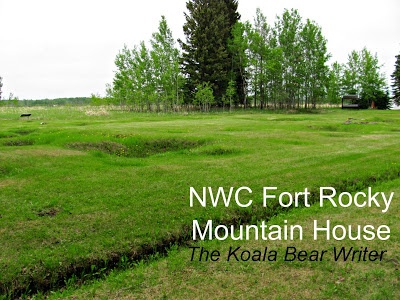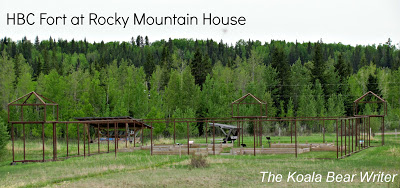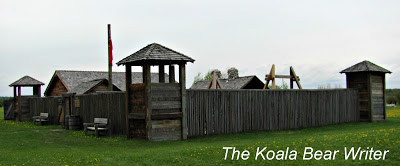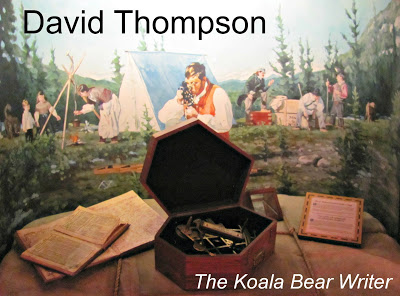On our whirlwind trip to Alberta and back last week, I stopped at Rocky Mountain House National Historic Site. Rocky Mountain House was founded in 1799 when the North West Company and the Hudson’s Bay Company both sent men out to build forts and establish trade with the local tribes. Today, the archaeological remains of the forts can be found a few kilometers away from the town.
Driving up the road to the interpretive centre, we could see the bison paddock and the playfort. The land is flat, with lots of spruce and poplar trees, and contrary to the name, you cannot see the mountains.
Once I’d paid my admission, I started hiking down the road towards what was left of the forts. The NWC fort is now a grassy meadow with a few trenches and holes to show where the walls and buildings would have been. I stood in the middle, looking at the rocks indicating where chimneys had been, and tried to imagine how it looked two hundred years ago. It was smaller than I’d thought it would be.

From the NWC fort, the trail continued down the hill along the river toward the HBC fort. This fort has been “outlined” with iron bars to mark the walls and wood boxes to mark where the buildings would have stood. Signs explained more about the fort, based on the information historians have been able to gather from fur trade journals and archaeology.
Even the identities of the forts—which one is which—is guesswork. Current identifications are based on a comment in Alexander Henry’s journal about the HBC fort being on the flood plain and the NWC fort being on a hill.

I followed the trail along the swollen North Saskatchewan River back to the interpretive centre. Chickadees and other birds sang in the trees and poplar fuzz floated through the air. I imagined being a fur trader—or a fur trader’s wife—here two centuries ago, when the river was the highway and this was a meeting place for many different groups of peoples. Today, there are places to camp around the river and a fence to keep the bison out of the way.
Along the trail to the forts are several places where you can stop and read or listen to more information on the forts and the people who lived there. Down by the HBC fort is an exhibit about north canoes and the routes fur traders would have taken to get furs and trade goods from Montreal to Rocky Mountain House. Again, the canoe was smaller than I’d expected, knowing how many men and how much cargo it had to carry up and down the rivers.
Near the interpretive centre is a Metis camp, a York boat, and a playfort. The fort is a replica of a fur trade fort, built mostly to give kids something to play in. I didn’t explore the trail on the other side of the centre, where the “newer” forts had been built after 1835 as I was running out of time to explore.

In the interpretive centre, I took a quick look at the exhibits. There was a fur trade room, murals on the walls, mannequins showing what men and women of the fur trade would have worn, a birchbark canoe and a replica of David Thompson’s map, and a bust of Thompson’s wife Charlotte Small. There were also some interactive exhibits for the kids, including dress up clothes and a magnetic York boat that kids could “load” with barrels and fur trade supplies.

Because I walk fast and read fast and had a brief time to spend there, I covered everything in about two hours. The interpretive centre provides a map of the grounds which suggests that it takes two hours to tour the outside forts, plus extra time to read the exhibits inside (most of which I skimmed because I’ve read or learned it elsewhere).
I was quite impressed at how kid-friendly the exhibits were, as we’ve been at a lot of museums with our girls where I’m trying to keep them busy while reading stuff they aren’t at all interested in. Admission was also very reasonable (around $10 for a family for the day).
If you do head out to Rocky Mountain House National Historic Site, I recommend taking a picnic lunch, as there were many nice places to relax and enjoy the park while you’re visiting.

10 Comments
When I used to travel for business I hit Alberta often but have never had the opportunity to explore. This is going onto my bucket list for Canadian travel.
Ah, yeah, when you’re traveling for business it’s hard to do all the fun things you want to! We’ve also had short trips lately because we’re trying to fit in as much visiting as possible with friends and family there, so I wasn’t sure I’d have time to go exploring. 🙂
I have never been to Alberta before. It is on my travel list .so beautiful
It is a beautiful province. 🙂 I hope you make it there someday! 🙂
I love how kid friendly and approachable this place sounds. Very cool looking place. Thanks for the write up!
I was also quite impressed at how kid-friendly it was, because we’ve been to quite a few museums with our girls and usually it’s a struggle to keep them interested. 🙂 They would have loved Rocky, so I might take them back someday. 🙂
We camped at Crimson Lake which isn’t far from there, if I remember correctly…beautiful! We never actually went to Rocky Mountain because we had been to Fort Edmonton and Fort Walsh already and ran out of time, both which you would love, if you loved this…they are bigger. There’s also a corn maze near Rocky Mountain that would be fun. Great post! We’re headed out to Cypress again this summer for a camping trip; 4th time and we love it every time; have you been?
I’ve been to Fort Edmonton two or three times – it is much bigger than Rocky. 🙂 Never been to the corn maze or to Cypress, though I’ve heard Cypress is beautiful. Maybe someday! 🙂
I would love to go back and explore more of Alberta, I have only been once just after I was married. I would love to take the kids to be able to experience all that Alberta has to offer
There is so much to do in Alberta! I grew up there, but it feels like I only recently discovered some of the great places to explore there. 🙂